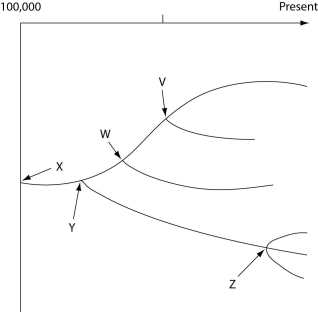The following questions refer to the evolutionary tree in Figure 22.2.
The horizontal axis of the cladogram depicted below is a timeline that extends from 100,000 years ago to the present; the vertical axis represents nothing in particular. The labeled branch points on the tree (V-Z) represent various common ancestors. Let's say that only since 50,000 years ago has there been enough variation between the lineages depicted here to separate them into distinct species, and only the tips of the lineages on this tree represent distinct species.

Figure 22.2
-How many separate species, both extant and extinct, are depicted in this tree?
Definitions:
Production Possibilities Curve
A graphical representation that shows the maximum possible output combinations of two goods or services an economy can achieve when all resources are fully and efficiently utilized.
Efficient
Characterizes a system or process that achieves its goals with minimal waste of time, resources, or effort.
Unattainable
Something that cannot be achieved or reached, often used in the context of goals or objectives that are beyond reach due to current limitations.
Outward Shift
An increase in the production capacity of an economy, often represented as an outward movement on a graph.
Q6: What must occur for asexual reproduction to
Q18: The elongation of the leading strand during
Q19: Which statement about the domain Archaea is
Q24: At some time during their existence, bryophytes
Q24: Bird guides once listed the myrtle warbler
Q26: The movement of these blocks suggests that<br>A)
Q26: In large scale, genome-wide association studies in
Q35: You are given an unknown organism to
Q37: If she moves the promoter for the
Q57: If humans had been present to build